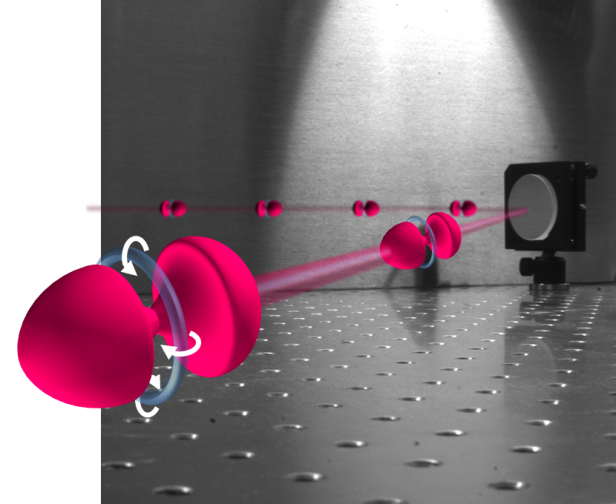A team of physicists from University of Maryland has discovered that high-intensity laser is capable of producing violent swirls of optical energy that strongly resemble smoke rings.
These donut-shaped light structures, known as ‘spatiotemporal optical vortices’ or STOVs, can travel along with the laser pulse at the speed of light and control the flow of energy around it. And, researchers believe this discovery not only could explain decades’ worth of anomalous results and unexplained effects in the field of high-intensity laser research, they could also open up new ways to design powerful microscopes and more efficient telecommunication lines.
“Lasers have been researched for decades, but it turns out that STOVs were under our noses the whole time,” said Howard Milchberg, senior author of the study, in a news release. “This is a robust, spontaneous feature that’s always there. This phenomenon underlies so much that’s been done in our field for the past 30-some years.”
Given the right conditions, these light structures can be created with any powerful lasers. These laser beams are what physicists have been analyzing. They have the property to self-focus, and as they travel along a straight path, they get more intense. Regular lasers do not have this and as they are bound by the wave nature of light, they gradually expand in size as they travel.
The light energy carried by this high intensity laser light is controlled by the STOVs and it flows through the inside of the right and then loops back around outside. STOVs are useful because they are time dynamic, meaning they travel along with the central laser pulse. They are more broadly useful for engineering applications compared to other laser vortices. The thin, gray ring-like objects visualized in the picture below are the STOVs.

“Conventional optical vortices have been studied since the late 1990s as a way to improve telecommunications, microscopy and other applications. These vortices allow you to control what gets illuminated and what doesn’t, by creating small structures in the light itself,” said Nihal Jhajj, the lead author of the paper.
“The smoke ring vortices we discovered may have even broader applications than previously known optical vortices, because they are time dynamic, meaning that they move along with the beam instead of remaining stationary,” Jhajj explained. “This means that the rings may be useful for manipulating particles moving near the speed of light.”
There is another type of vortex known as ‘orbital angular momentum’ (OAM) vortex, where light energy circulates around the beam propagation direction (as visualized below). This vortex can influence the shape of the central beam. Because of this, it has been proven useful for advanced applications such as high-resolution microscopy and telecommunication.

“All the evidence we’ve seen suggests that STOVs are universal,” Jhajj explained. “Now that we know what to look for, we think that looking at a high-intensity laser pulse propagating through a medium and not seeing STOVs would be a lot like looking at a river and not seeing eddies and currents.”
Researchers have not fully understood physical and theoretical implications of the STOVs and how they operate. They have just been discovered, and researchers are particularly excited for new opportunities that will arise in basic laser research. However, considering their ability to travel with the central beam at the speed of light, STOVs may have potential to expand the effective bandwidth of fiber-optic communication lines.
“A STOV is not just a spectator to the laser beam, like an angel’s halo,” explained Milchberg, noting the ability of STOVs to control the central beam’s shape and energy flow. “It is more like an electrified angel’s halo, with energy shooting back and forth between the halo and the angel’s head. We’re all very excited to see where this discovery will take us in the future.”
Source: University of Maryland
Reference: Spatiotemporal Optical Vortices – Physical Review X

Laser Science is very interesting and looking forward to new ways it can be used.
LikeLike